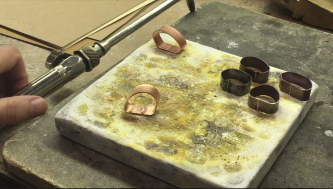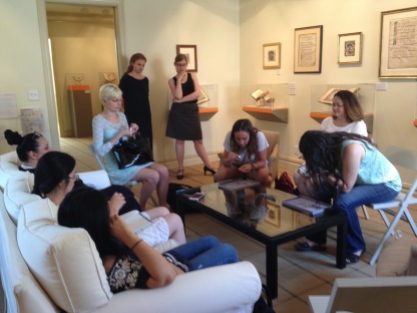Reconstructing a 16th-century chain
I am fascinated by the imposing Brustketten (“breast chains”) depicted in female portraits by Lucas Cranach the Elder, a 16th-century German painter. So I decided to undertake a reconstruction project at the Jewelry Arts Institute studio in midtown Manhattan.
To understand the chain’s fabrication, I combine my visual analysis of the jewellery featured in Cranach’s paintings with making a copper prototype.
This process of looking and doing begins with sketching out the chain’s links. This first step in pencil and paper is vitally important to my reconstruction process. The act of drawing connects me to the artisanal jewellery-making technologies encoded in the painting’s details. I understand the shadows and highlights that Cranach uses to depict the links as an accurate representation of the metal’s shape – in other words, I “read” Cranach’s painting as a kind of goldsmith’s blueprint.
My knowledge of the goldsmithing techniques that went into creating these chain links enables me to conceptualize their physical construction five centuries later.
Capturing the aesthetic of Cranach’s chain in a modern adaptation is another matter altogether. This requires experimentation at the bench. I use copper to prototype for its malleability.
…more soon! This project is on pause until COVID-19 restrictions are lifted in New York City. Going forward, I plan to experiment with copper patination based on pre-Columbian techniques shared with me by my colleague Andrew Lacey, bronze sculptor and archaeo-metallurgist in Devon, England.
Histories of Jewellery
Jewellery has a history, arguably even many kinds of histories. As an artifact, jewellery can open up a window into the time and place of its creation through the study of its materials, construction, and design. Yet a piece of jewelry is much more than the sum total of its parts. Jewellery is a dynamic document of human experiences; its meaning becomes activated when worn upon the body.
My views on teaching histories of jewellery as an inherently practical subject began at Columbia University in 2016 with the undergraduate lecture course that I designed and led, “Material World Of Jewellery.” This course examined jewellery as a primary source for studying interrelationships between decorative arts, scientific and technological innovations, mercantile commerce, and society across the last five hundred years.
This course was also based upon experiential learning through the handling of actual historical jewellery pieces and jewellery-making tools. This hands-on aspect more than anything demystified jewellery for my students. I blended assigned readings and class discussion with a three-part field trip — first to see jewellery on exhibit at the Met Museum, then to experience a handling session with rings from 100 BCE to 1700 CE at the New York gallery Les Enluminures (co-taught with goldsmith Jeanette Caines), culminating with hands-on bench work at the Jewelry Arts Institute under the guidance of Ms. Caines, JAI Director.
My teaching experience in jewellery history includes courses at the Bard Graduate Center: Decorative Arts, Design History, Material Culture and Nunavut Arctic College. I have presented lectures and public programs at various conferences and museums internationally. I have also contributed short essays for jewellery exhibitions, such as “The Jeweler’s Art and Alchemy” in 45 Stories in Jewelry: 1947 to Now at the Museum of Arts and Design (MAD) in New York City (February 13, 2020 – January 24, 2021), and Coda: The Jeweler’s Bench for “A View from the Jeweler’s Bench: Ancient Treasures, Contemporary Statements” at the Bard Graduate Center (February 14 – July 7, 2019).
.
.
© Donna Bilak and dbilakpraxis.com (2012–2021)


















